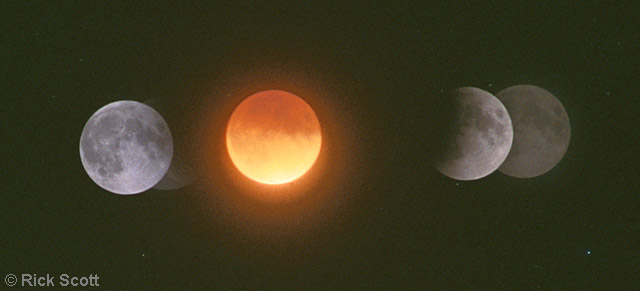

During the evening of 20 January 2000, one of natures astronomical shows occurred for any one on Earth that was able to see the moon. That night, the moon passed through the Earth's shadow creating a total lunar eclipse. My location in central Arizona had some high thin clouds passing through, but that didn't stop me from watching and photographing this wonderful event. I brought my kids outside at various times to see the moon as its apparent shape changed during the course of the eclipse. My binoculars were set up on a camera tripod for them to view the moon and they really enjoyed the show. There were moments during the total phase when the moon reminded me of viewing Mars. The color was a deep ruddy orange with a bright "polar cap".
I photographed this event with one of my Olympus OM-3 bodies attached to the top of my Celestron 8" Schmidt Cassegrain Telescope. The telescope was on my Losmandy G-11 equatorial mount which made for a stable platform for the camera to track the Earth's shadow. This photograph is a multiple exposure of seven exposures, all done in the camera. Due to the clouds effects on the exposures, some of them are not visible or are extremely faint. The image I was trying to capture was to have the moon clearly show the shape of the Earth's shadow. The photograph didn't turn out exactly as I wanted it to, but I still like the result, so here it is for me to share with you.
I used my Zuiko (Olympus) 180mm f/2.8 lens and Fuji Provia 100 film. Various aperture and shutter settings were used during the course of about four hours as the brightness of the moon varied. For the brightest moon in the penumbral shadow I used f/11 at 1/125 sec. For the deep total eclipse, I exposed the film for 2-1/2 minute af f/4. I scanned the image with a Nikon Coolscan LS-2000 and Adobe Photoshop. Photograph by Rick Scott.
Updated: 4 February 2000